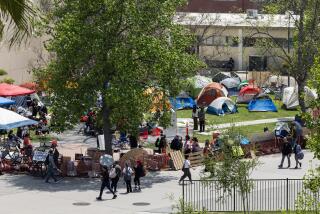City Parks Need Overhaul
Ardmore Recreation Center is a modest square block of turf in a dense Koreatown neighborhood. It is like many of the city’s 385 parks: a gym, a baseball diamond, a children’s play area, a few concrete tables and benches. Nothing fancy.
Ardmore gets heavy use, and while the park’s staff obviously tries to keep the place up, the gym is old and worn, the asphalt parking lot ripples in spots, and the security cages around the park office has a penitentiary look. Ardmore mirrors the pressures that face Ellen Oppenheim, new general manager of the Los Angeles recreation and Parks Department.
The Board of recreation and Parks Commissioners, to which Oppenheim reports, focused on Ardmore earlier this month in voting to rename it Seoul International Park to better reflect the neighborhood. Yet it will take more than a name change to reinvigorate Ardmore and other local parks.
A visit to the park on a weekday afternoon finds it busy, even at this off-peak time. With less than an acre for every 1,000 residents, Los Angeles has far less parkland than any other major city.
Moreover, the city’s dense, central core has fewer and smaller parks than the Valley and Westside. With so little turf, constant use, especially by soccer players, has pounded grass fields across the city to hard-packed dirt. Gym floors, play equipment and restrooms all show unacceptable wear. Park conditions are a quality of life issue, and as Oppenheim says, “dinner table talk for many families.”
There are some hopeful signs. Small “pocket parks” are being developed on abandoned land in some of the grittier neighborhoods. Creative joint-use agreements will allow park sports teams onto school athletic fields after school hours. Propositions A and K, which voters passed since 1992, are now paying for facilities improvements that have been delayed 20 years. These are important steps, but the city still has to use its park space better. Three priorities:
* Empower the park directors. On paper, these men and women are in charge at individual parks. In practice, they are captive to an overburdened and often unresponsive gardening and maintenance staff. Burned-out light bulbs go unreplaced for weeks at some parks. Gardeners report to district maintenance supervisors rather than park directors. Some parks wait years just to get sand replenished in their play areas. The directors on site should have the power to ensure timely repairs and upkeep, and should be held accountable for them.
* Shake up the maintenance staff. The culture of “no” is firmly in place here. Yes, there is too little money and too much to do, but the establishment of performance standards, clearer lines of authority and decentralization should help.
* Start with field upkeep. Deteriorating playing fields generate complaints in every corner of the city. Yet no one wants to-- or feels empowered to-- close a field and re-grass it. It may be hard to enforce closures, and money may be scarce for lawn fertilizer and seed. However, soccer fields in other cities, like Santa Monica, also get super-heavy use, but parks there let them rest periodically to regenerate. Oppenheim can demonstrate her commitment by finding a way to do the same in Los Angeles.
More to Read
Start your day right
Sign up for Essential California for news, features and recommendations from the L.A. Times and beyond in your inbox six days a week.
You may occasionally receive promotional content from the Los Angeles Times.






